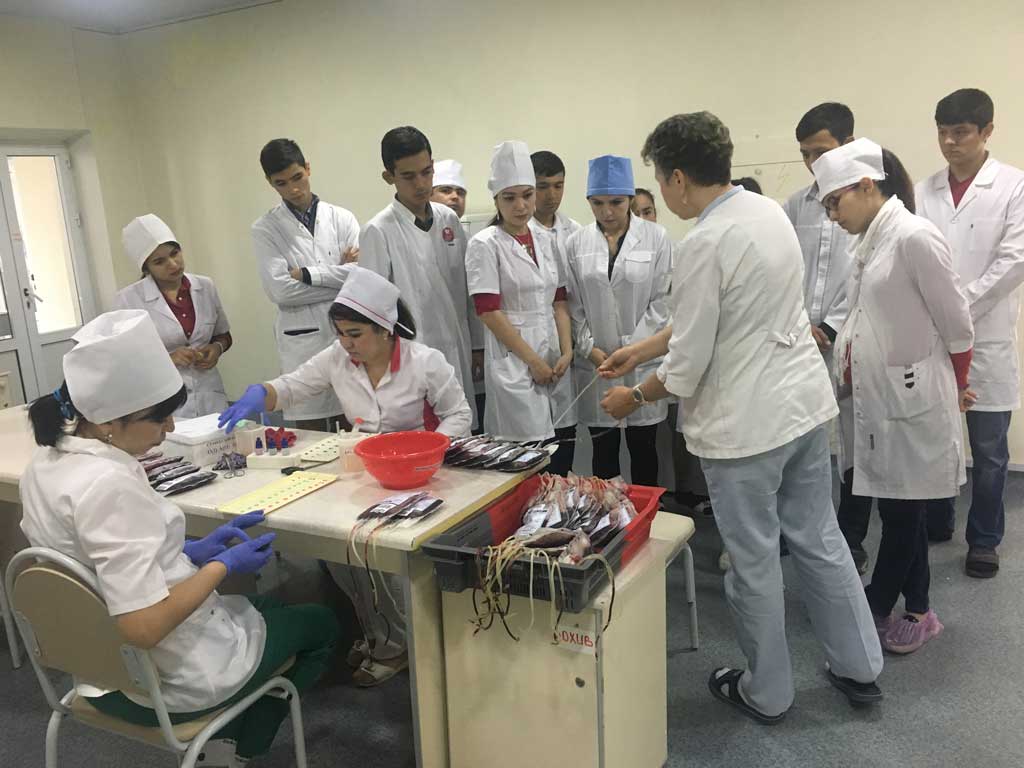The list of practical skills in Hematology, VPT and
laboratory for students of the medical, medico-pedagogical faculties:
PRACTICAL SKILLS IN HAEMATOLOGY
5 – course
- Hemogram in IDA.
- Coagulation in DIC-2-stage.
3.Determination of clotting time on the slide.
4.Definition of bleeding time by Duke
- Complete blood count in acute leukemia
- Determination of hemolysis.
- Hemogram in B12 deficit. anemia.
- Gipoplasticescoy hemogram in anemia.
VAC 5 – COURSE
1.General principles of treatment of acute poisoning.
2.Emergency care for fainting in the military field.
3.General principles and measures of emergency therapeutic aid to the wounded and sick on the stages of medical evacuation.
4.Treatment of chronic radiation sickness in the period of exacerbation.
5.Measures to prevent further exposure of radioactive substances to the skin and mucous membranes.
6.The provision of emergency assistance to WFP, with cardiac asthma in the military field.
THE LIST OF STAGES (STEPS) PRACTICAL SKILLS IN HEMATOLOGY , VPT AND LABORATORY FOR THE STUDENTS OF THE MEDICAL , MEDICO-PEDAGOGICAL FACULTIES :
On Hematology for the 5-course mastering each skill is performed in 5-10 steps and estimated maximum of 100 points.
- Hemogram in IDA.
Knowledge of the interpretation of the haemogram with IDA is important for diagnosis of this pathology.
Objective: to know the indicators of a haemogram at IDA.
Indications: patients with IDA.
Sequence of actions:
No. sequence of actions Failure to comply with step(0 points)
The right step
- NV – Reduced
Eric-. Reduced
- P.—0.8 and below
- Leukocytes in the normal range. 0 20
- Platelets within normal limits. 0 20
- Leucoformula: within normal limits. 0 20
- ESR— within normal limits or speeds up. 0 20
Red blood cell morphology: Hypochromia, micronization
Total 0 100
Coagulation in DIC-2-stage
Knowledge of coagulation in DIC is important in the diagnosis of this pathology
Objective: to know the coagulation in DIC
Indications: patients DVS – syndrome.
Sequence of actions:
No. sequence of actions Failure to comply with step(0 points) Correct execution of step (100 points)
- VSK – 10-20 min.
The bleeding time is 10-20min.
The number of platelets – 100 * 109
- Colin-kefalevoe time – 50″
Prothrombin time –25C.
- Tolerance of plasma to heparin-21
Fibrinogen plasma – 2G/L.
Fibrinolytic activity – 120″
- Decomposition products:
PRF – polozhit.
The ethanol test- – polojit
Preteenlolita Proba- – polojit
- Retraction of blood clot – 02
Adhesion retention of platelets – 7%
Hemolysate – Agregat. Test -10″ 102
21″ 10 6
3.Definition of bleeding time by Duke.
Determination of bleeding time according to Duke is important in diseases involving violations of platelet hemostasis.
Objective: to determine bleeding time.
Indications: all patients with diseases involving violations of platelet hemostasis.
Equipment: scarifier, filter paper, stopwatch.
The sequence of determining the bleeding time according to Duke.
No. sequence of actions failure to comply with the step
(0 points) Correct execution of step(100 points)
- The scarifier is pierced by the 4 – finger or earlobe. 0 20
- After a puncture to start the clock. 0 10
- Speaking from the first drop with filter paper, remove the blood every 30 seconds.
- Continue the manipulation until on filter paper will remain traces of blood. the stopwatch is turned off
- The rate of bleeding duration to 5 minutes
Determination of clotting time on the slide.
- Determination of clotting time on the slide is important in diseases associated with the violation of plasma hemostasis and for monitoring the effectiveness of geparinoterapii.
Objective: to determine the clotting time.
Indications: all patients with diseases associated with the violation of plasma hemostasis and patients receiving direct anticoagulants.
Equipment: scarifier, slide, stopwatch.
Sequence of determination of clotting time on the slide.
No. sequence of actions Failure to comply with step(0 points) Correct execution of step(100 points)
- The scarifier to pierce your finger on a glass slide and drip a drop of blood.
- Using the scarifier drop stir clockwise, turn on the stopwatch.
- Record the appearance of the first fibrinoly thread—the beginning of the clotting time.
- With the appearance of a blood clot—record the time and turn off the stopwatch—the end of the clotting time.
- Norma—early 30s.-2 min., the end of 3-5 min. 0 10
Total 0 100
Complete blood count in acute leukemia.
Knowledge of the interpretation of the haemogram in ar is essential for diagnosis of this pathology.
Objective: to know the indicators of a haemogram at OL.
Indications: patients with OL.
Sequence of actions:
No. sequence of actions failure to comply with the step
(0 points) Correct execution of step
- NV – Reduced
Eric-. Reduced
- P.—0,85-1,05.
- The leukocytes May be within the normal range, increase or decrease 0 20
- Platelets Are Reduced. 0 20
- Leucoformula: the Appearance of blasts. Leukemic failure. 0 20
- Erythrocyte sedimentation rate is accelerated. 0 20
Total 0 100
DETERMINATION OF HEMOLYSIS.
The ability to establish that hemolysis is important, as it allows to quickly establish the diagnosis and provide timely emergency care.
Objective: to establish the fact of hemolysis developed after transfusion of blood incompatible.
Indications: patients receiving a blood transfusion.
Sequence determination of hemolysis:
No. sequence of actions Failure to comply with step(0 points)
The right step
The patient complains of acute pain in the abdomen, lower back. 0 20
- The appearance of jaundice sclera, palms. 0 20
- Express-method for staining of blood serum by centrifugation. 0 25
- Dark urine. 0 25
- Decreased blood pressure, increased heart rate, increased body temperature. 0 10
Total 0 100
Hemogram in B12 deficit. anemia.
Knowledge of the interpretation of the haemogram in B12 – deficit anemia is important to diagnose this pathology.
Objective: to know the indicators of a haemogram at B12 deficit. anemia
Indications: patients with a B12 deficit. anemia.
Sequence of actions:
No. sequence of actions Failure to comply with step(0 points) Correct execution of step
- NV – Reduced
Eric-. Reduced
CP—1.1 and above.
- Leukocyte – Reduced. 0 20
- Platelets Is Reduced. 0 20
- Leucoformula: within normal limits. 0 20
- ESR— within normal limits or speeds up. 0 20
Red blood cell morphology: Hyperchromia, macrobiotics,Taurus Jolly, rings Kebot.
Morphology of leukocytes: hypersegmented nuclei of neutrophils.
Total 0 100
Gipoplasticescoy hemogram in anemia.
Knowledge of the interpretation of the haemogram in gipoplasticescoy of anemia is important to diagnose this pathology.
Objective: to know the indicators of a haemogram at gipoplasticescoy anemia.
Indications: patients with gipoplasticescoy anemia.
Sequence of actions:
No. sequence of actions Failure to comply with step(0 points) Correct execution of step
- NV – Reduced
Eric-. Reduced
- P.—0.8 and below
- Leukocyte – reduced. 0 20
- Platelet count is reduced to 0.. 20
- Leucoformula: lymphocytosis. 0 20
- Erythrocyte sedimentation rate is accelerated. 0 20
- Red blood cell morphology: Hypochromia
- On Hematology for 6-course mastering each skill is performed in 5-10 steps and estimated maximum of 100 points.
1.PREPARATION OF THE PATIENT TO CONDUCT THE BLOOD TRANSFUSION.
Preparation of the patient to conduct a blood transfusion is essential for the procedure without complications.
Objective: to prepare the patient to conduct the blood transfusion.
Indications: all patients in need of blood transfusion.
The sequence of preparation of patient for blood transfusion:
No. sequence of actions failure to comply with the step
(0 points) Correct execution of step
- Based on clinical and lab. examination of the patient to exclude contraindications to a hemotransfusion.
- The measurement of body temperature. 0 20
- Measurement of blood pressure. 0 20
- In the presence of febrile reactions in history to hold a premedication NSAIDs. 0 20
- To hold all the individual samples. 0 20
Total 0 100
MONITORING OF THE PATIENT AFTER THE TRANSFUSION.
Monitoring of the patient after the transfusion, it is important for
prevention of late post-transfusion complications.
Purpose:monitor the patient after the transfusion, it is important
for the prevention of late post-transfusion complications.
Indications: all patients received blood transfusion.
Sequence of actions:
No. sequence of actions Failure to comply with step (0 points) Correct execution of step
- After the transfusion, the patient should lie down for 20-30 min. 0 15
- The doctor after the procedure, the patient measures blood pressure and pulse. 0 25
- Doctor in history, wrote the Protocol of a blood transfusion. 0 20
- Monitoring of the patient should be carried out during the day. 0 25
- The morning after the transfusion, the patient delivers the KLA, OAM. 0 15
Total 0 100
3.FIRST AID WITH THE DEVELOPMENT OF THE PATIENT POST-TRANSFUSION REACTIONS.
The ability to provide 1 – assistance in the development of post-transfusion reactions is important, since timely first aid can save the life and health of the patient.
Goal: learning the skill in first aid to the patient in the development of post-transfusion reactions.
Indications: patients who have observed a post-transfusion reaction.
The sequence of first aid to the patient in the development of post-transfusion reactions.
No. sequence of actions Failure to comply with step(0 points) Correct execution of step
- To impose a patient with heaters, to give the hot drink. 0 20
- Hypotension in\in infusion solutions, injection mezatona, GCS. 0 10
- In allergic manifestations in\in p-p 10% calcium chloride injection of antihistamines. 0 30












